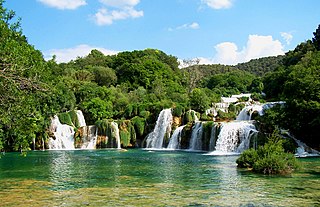
Krka National Park is one of the Croatian national parks, named after the river Krka that it encloses. It is located along the middle-lower course of the Krka River in central Dalmatia, in Šibenik-Knin county, downstream Miljevci area, and just a few kilometers northeast of the city of Šibenik. It was formed to protect the Krka River and is intended primarily for scientific, cultural, educational, recreational, and tourism activities. It is the seventh national park in Croatia and was proclaimed a national park in 1985.
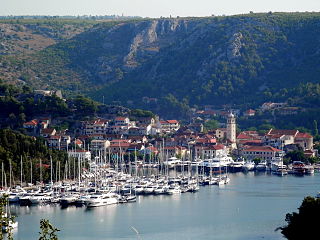
Skradin is a small town in the Šibenik-Knin County of Croatia, with a population of 3,825. It is located near the Krka river and at the entrance to the Krka National Park, 17 km (11 mi) from Šibenik and 100 km (62 mi) from Split. The main attraction of the park, Slapovi Krke, is a series of waterfalls, the biggest of which, Skradinski buk, was named after Skradin.

Krk is a Croatian island in the northern Adriatic Sea, located near Rijeka in the Bay of Kvarner and part of Primorje-Gorski Kotar county. Krk is the largest Adriatic island, with an area of 405.80 km2 (156.68 sq mi), Krk is the most populous island in the Adriatic Sea, with multiple towns and villages that contain a total of 19,383 (2011) inhabitants.
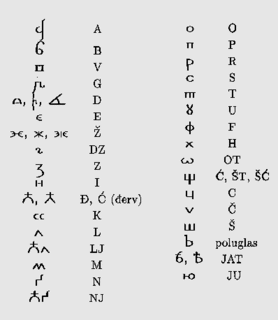
Bosnian Cyrillic, widely known as Bosančica is an extinct variant of the Cyrillic alphabet that originated in medieval Bosnia. The term was coined at the end of the 19th century by Ćiro Truhelka. It was widely used in modern-day Bosnia and Herzegovina and the bordering areas of modern-day Croatia. Its name in Bosnian-Croatian-Serbian is Bosančica and Bosanica the latter of which can be translated as Bosnian script. Some Serbian scholars consider it as part of variant of Serbian Cyrillic and term "bosančica" according to them is Austro-Hungarian propaganda. Croat scholars also call it Croatian script, Croatian–Bosnian script, Bosnian–Croat Cyrillic, harvacko pismo, arvatica or Western Cyrillic. For other names of Bosnian Cyrillic, see below.

In 2018, Croatia had 19.7 million tourist visitors who made 110 million overnight stays.

Hvar is a city and port on the island of Hvar, part of Split-Dalmatia County, Croatia. The municipality has a population of 4,251 (2011) while the city itself is inhabited by 3,771 people, making it the largest settlement on the island of Hvar. It is situated on a bay in the south coast of the island, opposite from the other nearby towns of Stari Grad and Jelsa.
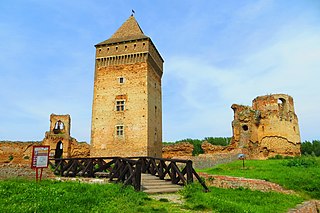
Bač is a town and municipality located in the South Bačka District of the autonomous province of Vojvodina, Serbia. The town has a population of 5,399, while Bač municipality has 14,405 inhabitants. The entire geographical region between the rivers Danube and Tisza, today divided between Serbia and Hungary, was named Bačka after the town.

Mary of Jesus of Ágreda , OIC, also known as the Abbess of Ágreda, was a Franciscan abbess and spiritual writer, known especially for her extensive correspondence with King Philip IV of Spain and reports of her bilocation between Spain and its colonies in New Spain. She was a noted mystic of her era.

Lopud is a small island off the coast of Dalmatia, southern Croatia. Lopud is economically the most developed of the Elaphiti Islands, and can be reached by boat from Dubrovnik, Trsteno, Orašac and Zaton. The island is famous for its sandy beaches, in particular the bay of Šunj. Lopud is the second largest island of the Elaphiti islands, between Koločep and Šipan. It is famous as the "island in the middle". It has an area of 4.63 square kilometres and its highest point is Polačica, 216 metres above sea level. It has 11.5 km (7 mi) of coastline, of which 1.2 km (1 mi) is sandy.
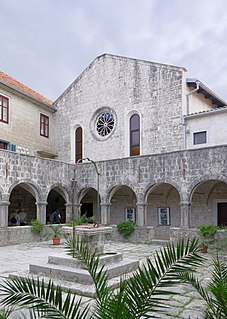
Košljun is a tiny island in Puntarska Draga bay off the coast of Krk, facing Punat, in the Adriatic Sea, Croatia. It is approximately 300 meters in diameter and covers an area of 6.5 hectares and is rich in vegetation. The only inhabitants are a group of Franciscan friars living in St. Mary's Monastery.
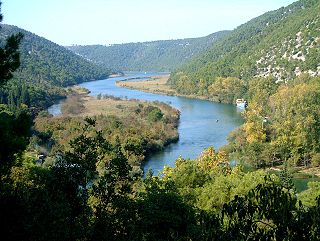
Krka is a river in Croatia's Dalmatia region, known for its numerous waterfalls. It is 73 km (45 mi) long and its basin covers an area of 2,088 km2 (806 sq mi). It was known in ancient Greek as Kyrikos, or may be also as Catarbates by the ancient Greeks, it was known to the ancient Romans as Titius, Corcoras, or Korkoras.

The Krka Monastery is a Serbian Orthodox monastery dedicated to the Archangel Michael, located near the river Krka, 3 km east of Kistanje, in central Dalmatia, Croatia. It is the best known monastery of the Serbian Orthodox Church in Croatia and it is officially protected as part of the Krka National Park.
Prvić is a small island in the Croatian part of the Adriatic Sea. It is situated in the Šibenik archipelago, about half a mile from the mainland, in the vicinity of Vodice. The whole island is under protection of the Croatian Ministry of Culture since the island is considered a cultural heritage.

Armenian architecture comprises architectural works with an aesthetic or historical connection to the Armenian people. It is difficult to situate this architectural style within precise geographical or chronological limits, but many of its monuments were created in the regions of historical Armenia, the Armenian Highlands. The greatest achievement of Armenian architecture is generally agreed to be its medieval churches and seventh century churches, though there are different opinions precisely in which respects.

National and University Library in Zagreb (NSK) is the national library of Croatia and central library of the University of Zagreb.

The Franciscan Church of the Annunciation is a Franciscan church located on Prešeren Square in Ljubljana, the capital of Slovenia. It is the parish church of Ljubljana - Annunciation Parish. Its red colour is symbolic of the Franciscan monastic order. Since 2008, the church has been protected as a cultural monument of national significance of Slovenia.
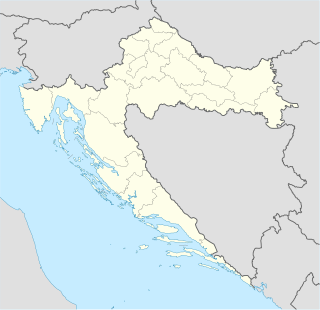
Miljevci or Miljevci plateau is a small region in Šibenik-Knin County in Croatia that includes seven villages. The plateau has an area of over 100 square kilometers and is located between the rivers of Krka, Čikola and mountain Promina. Miljevci are only a few kilometers from the town of Drniš in the east, and across the Visovac Monastery in the west. The majority of the population are Croats.

Franciscan monastery of the Holy Spirit is a Bosnian Franciscan monastery in Fojnica, Bosnia and Herzegovina. It was founded in 1668 and it includes a library of ca. 12,500 volumes, including 13 incunabula and 156 works written in Bosnian Cyrillic. It is a designated National Monument of Bosnia and Herzegovina. It is part of the Franciscan Province of Bosna Srebrena.

Franciscan monastery of Saint Luke is a Franciscan monastery in Jajce, Bosnia and Herzegovina. The construction began in 1877 and it finished in 1885. In 1934-1935 the monastery was renovated by Karel Pařík. Franciscans in the 1970s tried to return the bones of St. Luke in Jajce, and since then the monastery carries the name of this evangelist.

Kamičak Castle is a ruined medieval fortified structure on a rock at the top of the hill above the Krka River in the Krka National Park, Croatia. It is situated not far from the Brištane village in the administrative area of the Town of Drniš, Šibenik-Knin County. Located between the Visovac Lake and Roški Slap waterfall, it perks up like an eagle in unreachable eagle's nest on the edge of a cliff. Once property of the powerful Nelipić noble family, the castle was captured and destroyed in 1522/23 by the [[Ottoman wars in >Talovac noble family<Europe|Ottoman invaders]], never to be rebuilt.





























